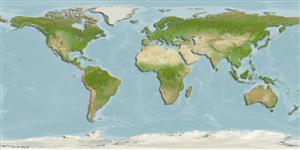>
Anguilliformes (Eels and morays) >
Ophichthidae (Snake eels) > Ophichthinae
Etymology: Ophichthus: Greek, ophis = serpent + Greek, ichthys = fish (Ref. 45335); tetratrema: Name from Greek words meaning four and hole, referring to the species' 4 preopercular pores; noun in apposition..
More on authors: McCosker & Rosenblatt.
Environment: milieu / climate zone / depth range / distribution range
पारिस्थितिकी
समुद्री बाथीड़िमरसल; गहराई सीमा 700 - 1000 m (Ref. 31243). Deep-water
Eastern Pacific: Costa Rica to Ecuador.
आकार / वज़न / Age
Maturity: Lm ? range ? - ? cm
Max length : 55.6 cm TL (female)
Short description
पहचान कुंजी | आकृति विज्ञान | मौरफोमैटरिक्स
जानवरों की रीड़ का जोड़: 156 - 157.
Maximum size 55.6 cm TL, refers to a female with undeveloped eggs.(Ref. 31243).
Life cycle and mating behavior
Maturities | पुनरुत्पत्ति | Spawnings | Egg(s) | Fecundities | लार्वा
McCosker, J.E. and R.H. Rosenblatt, 1998. A revision of the Eastern Pacific snake-eel genus Ophichthus (Anguilliformes: Ophichthidae) with the description of six new species. Proc. Calif. Acad. Sci. 50(19):397-432. (Ref. 31243)
IUCN Red List Status (Ref. 130435)
Threat to humans
Harmless
Human uses
मात्स्यिकी: कोई रुचि बग़ैर
साधन
Special reports
Download XML
इंटरनेट स्रोत
Estimates based on models
Preferred temperature (Ref.
123201): 4.1 - 5.8, mean 5.2 °C (based on 25 cells).
Phylogenetic diversity index (Ref.
82804): PD
50 = 0.5000 [Uniqueness, from 0.5 = low to 2.0 = high].
Bayesian length-weight: a=0.00089 (0.00039 - 0.00204), b=3.00 (2.80 - 3.20), in cm total length, based on LWR estimates for this (Sub)family-body shape (Ref.
93245).
Trophic level (Ref.
69278): 3.9 ±0.7 se; based on size and trophs of closest relatives
लौटाव (Ref.
120179): माध्यम, न्यूनतम जनसंख्या दुगनी होने का समय 1.4 - 4.4 वर्ष। (Preliminary K or Fecundity.).
Fishing Vulnerability (Ref.
59153): Moderate vulnerability (42 of 100).
